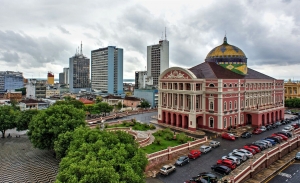India's architectural heritage stands as a testament to its rich cultural history, spanning thousands of years. From ancient temples to magnificent palaces, each structure tells a unique story of craftsmanship and royal grandeur. Let's explore eight of India's most stunning architectural marvels that continue to captivate visitors from around the world.
1. Taj Mahal, Agra
The crown jewel of Indian architecture, the Taj Mahal is a monument of eternal love. Built in pristine white marble, this 17th-century masterpiece showcases perfect symmetry and intricate details. The way sunlight plays on its dome throughout the day creates an ever-changing canvas of colors. The beautiful gardens and reflecting pools add to its timeless charm.
2. Hawa Mahal, Jaipur
Known as the "Palace of Winds," this pink sandstone wonder features 953 small windows decorated with detailed latticework. Built in 1799, the palace allowed royal ladies to observe street festivals while remaining unseen. Its unique honeycomb design and cool breeze-filled corridors make it an architectural marvel of the Pink City.
3. Khajuraho Temples, Madhya Pradesh
These temples showcase some of India's finest stone carvings. Built between 950 and 1050 AD, the complex includes 85 temples decorated with intricate sculptures. While famous for their erotic carvings, these temples actually depict various aspects of daily life, celestial beings, and divine love.
4. Konark Sun Temple, Odisha
Shaped like a massive chariot, this 13th-century temple is dedicated to the Sun God. The structure features 12 pairs of intricately carved wheels, representing the months of the year. The architectural precision is so remarkable that the first rays of the sun fall directly on the temple's main entrance.
For those wanting to experience these architectural wonders in luxury, the Maharaja Express train journey offers a unique perspective, allowing travelers to explore multiple destinations while enjoying royal comfort. This famous luxury train takes you through various architectural landmarks while providing insights into their historical significance.
5. Mysore Palace, Karnataka
The official residence of the Wadiyar dynasty, Mysore Palace blends Hindu, Muslim, Rajput, and Gothic styles. Its three-story structure features marble domes, a five-story tower, and beautiful stained-glass windows. When lit up with thousands of bulbs during special occasions, it creates a magical sight.
6. Golden Temple, Amritsar
The most sacred shrine for Sikhs, the Golden Temple's upper floors are covered in pure gold. The temple sits in the middle of a holy water tank, creating perfect reflections that enhance its beauty. The combination of Mughal and Indian architectural styles makes it a unique structure that welcomes people of all faiths.
7. Fatehpur Sikri, Agra
This red sandstone city, built by Emperor Akbar, showcases the finest blend of Persian and Indian architecture. The complex includes the famous Buland Darwaza, the tallest gateway in the world, and the tomb of Sufi saint Salim Chisti. The intricate carvings and peaceful courtyards transport visitors to the Mughal era.
8. Meenakshi Temple, Madurai
This colorful temple features 14 gateway towers (gopurams) covered with thousands of sculpted figures. The temple's architecture follows ancient Tamil Dravidian style, with each tower showcasing detailed mythological scenes painted in bright colors. The Hall of Thousand Pillars inside the temple is an architectural masterpiece.
Why These Destinations Matter
These architectural wonders are more than just tourist attractions; they represent India's diverse cultural heritage and engineering excellence. Each structure tells stories of different dynasties, religions, and architectural styles that have shaped India's identity. The precise mathematical calculations, astronomical considerations, and artistic elements in these buildings continue to amaze architects and visitors alike.
Many of these sites have received UNESCO World Heritage status, recognizing their universal value. They serve as important sources of learning about ancient building techniques, cultural practices, and historical events. Modern architects often draw inspiration from these structures, particularly their sustainable design elements and natural cooling systems.
Planning Your Visit
The best time to visit these architectural sites is during the winter months (October to March) when the weather is pleasant. Early morning visits offer the best lighting for photography and smaller crowds. Many sites offer guided tours that provide detailed information about the architecture and history.
Remember to respect local customs when visiting religious sites. Some places require removing shoes and covering heads. Photography might be restricted in certain areas, so always check the rules beforehand.
These magnificent structures continue to stand as proud symbols of India's architectural genius, drawing millions of visitors each year. They remind us that great architecture is timeless, telling stories that resonate across centuries and cultures.






